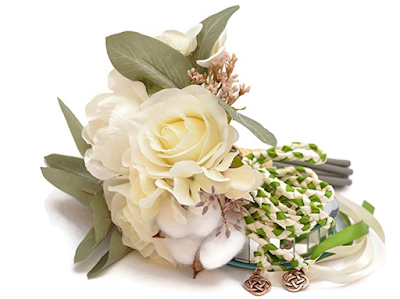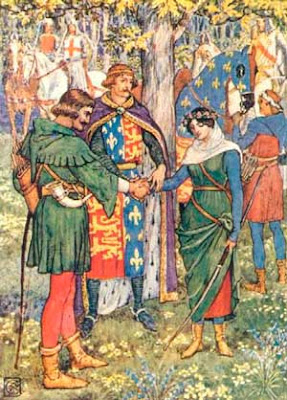Irish weddings are traditionally a time of celebrating family and friendships from around the world. It is a time of drinking, singing, laughing, and a hearty amount of partying. Amid the celebration, you'll find rich symbolism and a healthy dose of superstition. For this post we take a look at five popular Irish wedding traditions.
Irish wedding ring
Claddagh ring: The Irish Claddagh ring (pronounced “klahda”) is the traditional Irish wedding ring and also doubles as an engagement ring. Its distinguishing design offers unique symbolism and meaning that means different things depending on how you wear it. Each feature of the ring adds to its meaning: two hands (represent friendship) clasping a heart (symbolizing love) and usually topped by a crown (loyalty). While the meaning is clear, the origins of the Claddagh ring are shrouded among several legends.
Irish wedding band: Celtic knot wedding bands are the most popular design for Irish wedding bands because Celtic knot designs are crafted with a single thread that has no beginning or end. They symbolize the interconnection of life and eternity. On a wedding band, these loops are said to represent: eternal loyalty, faith, friendship, or love.
Handfasting
Before the church became involved in weddings, the handfasting ceremony was common in Ireland. It became the way couples were "officially" married. Today, this tradition is commonly used by couples for their unity ceremony, and the meaning of colors for handfasting cords adds another layer of symbolism and meaning to the couple’s special day.
Traditional Irish wedding toast
As far as wording goes, there isn’t one historic Irish wedding toast to fall back on. But the tradition of the Irish wedding toast does have a few idiosyncrasies to follow. Number one, the toast is to honor the couple. Even if the toast is funny, it should not put the bride and/or groom down. Secondly, it is common practice to use an Irish blessing, prayer, or proverb. For ideas, check out the Complete Guide to Irish Blessings.
Irish wedding bell tradition
The Irish wedding bell tradition started with the family giving the bride and groom a set of bells after they recited their vows. The couple rang the bells to ward off evil spirits and brought the bells home where they served as a reminder of the vows they made on their wedding day. Today, the Irish wedding bell is a popular wedding gift for Irish couples. It is to be kept in a prominent place in the home and when the couple argues they ring the bell to remind them of their wedding vows. If the dispute can’t be settled cordially, the bell is rung a little louder. This is supposed to purify and dispel stimulated emotions and change the perspective of the couple. This sounding of the bell also signals the end of the argument, even if neither the husband nor wife has ceded. It serves as a time out of sorts and allows the couple to cool down. For this reason, it is also known as the Irish make up bell.
The lucky Irish horseshoe
The horseshoe happens to be another Irish wedding icon. The shoes were traditionally given to the bride, most often by children following her wedding ceremony. She tied them to her bouquet and placed the whole lot next to the wedding cake during the wedding breakfast. I also read that the Celts sewed a horseshoe into the hem of the wedding dress for good luck. (This not only brought luck but also helped the dress hang properly). Have you ever wondered why a horseshoe was considered good luck in the first place? According to folk belief, iron held magical significance for the numerous Celtic tribes, and they thought it a lucky metal. Besides good luck, the Irish also believed the horseshoe to be a symbol of fertility. Following the wedding, the couple hung the horseshoe in their home, in the upright position like the letter ‘U’. This way luck gathered inside the U. (It’s worth noting that other societies believe the horseshoe should be hung upside-down to allow the luck to spill out on those who walk beneath it.
* * *
Some links in this post are affiliate links. We are a
participant in the Amazon Services LLC Associates Program, an affiliate
advertising program designed to provide a means for us to earn fees by linking
to amazon.com and affiliate sites.









